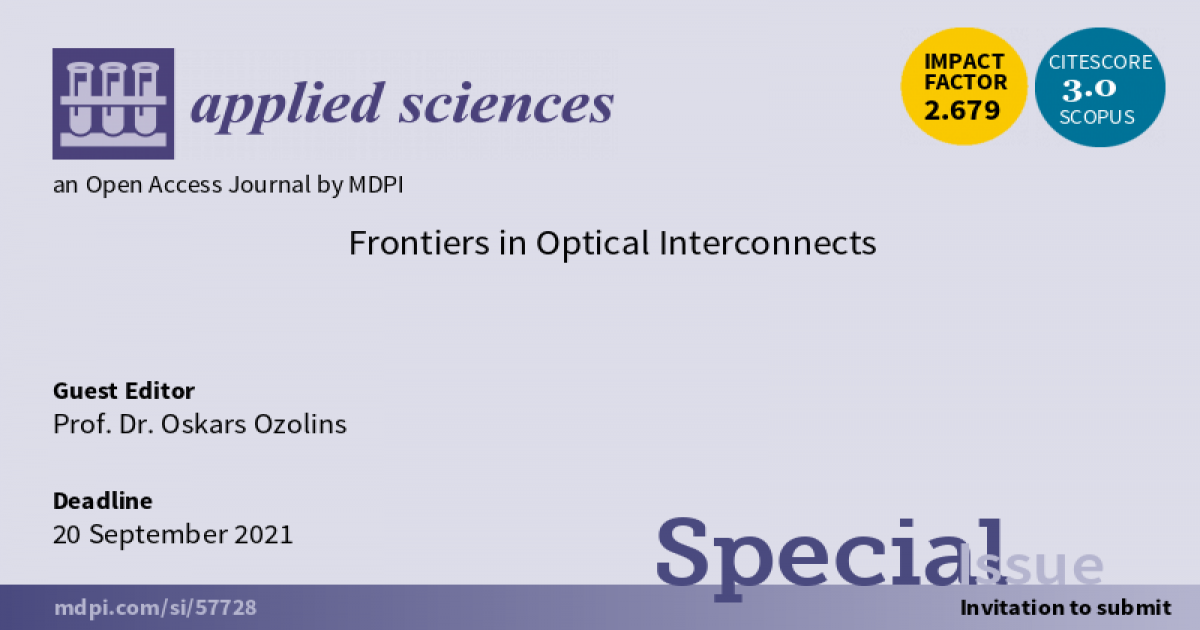Frontiers in Optical Interconnects
A special issue of Applied Sciences (ISSN 2076-3417). This special issue belongs to the section "Optics and Lasers".
Deadline for manuscript submissions: closed (20 September 2021) | Viewed by 6221

Special Issue Editor
Interests: fiber-optic communications; photonic–wireless systems; optical signal processing; optical interconnects
Special Issue Information
Dear Colleagues,
Modern technologies that support the Internet have transformed our lives. The Internet grows by 30% per year and consumes 9% of all electricity worldwide while transmitting hundreds of terabits per second. Global use of information grows continuously due to the demands of our society. We cannot continue the exponential growth of our use of information without significant reduction in energy consumption. This is a serious challenge for optical interconnects—how to reduce energy consumption and cost while increasing data rates.
Datacenters will continue to deploy optical interconnects to meet the required bandwidth density. The solution to energy-efficient and enormous bandwidth density optical interconnects is tight integration between electronics and photonics. We need to achieve high levels of integration with low manufacturing costs using integrated silicon photonics and wavelength-division-multiplexing technology. Innovation within photonics and electronics has enabled technologies to reduce energy consumption while supporting exponential use of information. A key enabler is the ring resonators for high throughput optical interconnects. Integration of optical technologies into datacenters will enable advances in machine learning and artificial intelligence. This will provide fast and reliable services to users worldwide.
Prof. Dr. Ozolins Oskars
Guest Editor
Manuscript Submission Information
Manuscripts should be submitted online at www.mdpi.com by registering and logging in to this website. Once you are registered, click here to go to the submission form. Manuscripts can be submitted until the deadline. All submissions that pass pre-check are peer-reviewed. Accepted papers will be published continuously in the journal (as soon as accepted) and will be listed together on the special issue website. Research articles, review articles as well as short communications are invited. For planned papers, a title and short abstract (about 100 words) can be sent to the Editorial Office for announcement on this website.
Submitted manuscripts should not have been published previously, nor be under consideration for publication elsewhere (except conference proceedings papers). All manuscripts are thoroughly refereed through a single-blind peer-review process. A guide for authors and other relevant information for submission of manuscripts is available on the Instructions for Authors page. Applied Sciences is an international peer-reviewed open access semimonthly journal published by MDPI.
Please visit the Instructions for Authors page before submitting a manuscript. The Article Processing Charge (APC) for publication in this open access journal is 2400 CHF (Swiss Francs). Submitted papers should be well formatted and use good English. Authors may use MDPI's English editing service prior to publication or during author revisions.
Keywords
- Optical interconnects
- Ring resonators
- Datacenters
- Energy-efficient
- Wavelength division multiplexing
- Silicon photonics





